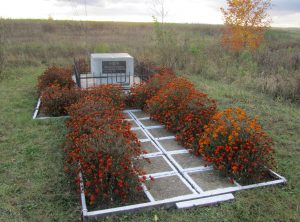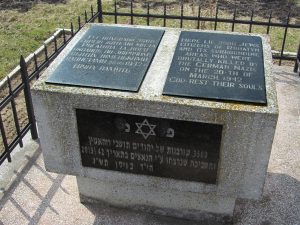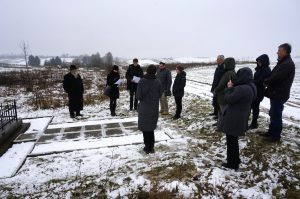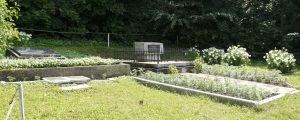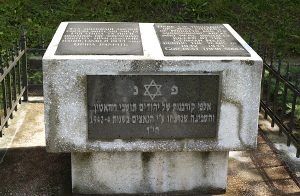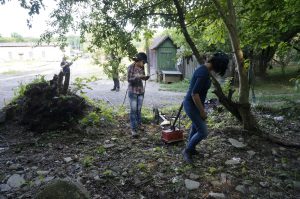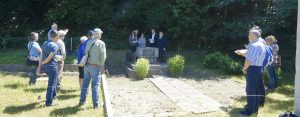![]() Ця сторінка також доступна українською.
Ця сторінка також доступна українською.
Introduction
The harassment, torture, and killing of Jews in Rohatyn began almost immediately after the Germans occupied the town in 1941, reached catastrophic proportions in 1942 and 1943, and then continued with persecution of the few survivors in hiding until the Germans’ westward retreat in 1944. The killing sites in town include the locations to two mass executions and burials, plus less precisely known locations of murders of smaller numbers of Jews in the ghetto, the town square, and the roads around town. More than a thousand Jews from Rohatyn and the surrounding area were also rounded up from the ghetto and shipped by train to the Nazi-built extermination camp near Bełżec; Rohatyn’s train station was the departure point for those victims. All of these sites can be visited in Rohatyn today; other pages on this website describe the locations and history of the wartime Jewish ghetto, the rynok, and the train station. Here we focus on the sites of the 1942 and 1943 mass shootings and burials:
- the south mass grave and memorial: 49.4035N, 24.6276E (49°24’12.7″N 24°37’39.4″E)
- the north mass grave and memorial: 49.4180N, 24.6080E (49°25’04.8″N 24°36’28.6″E)
Because these sites were deadly to Jews during the war (and thus few surviving Jews were witness to the events or even the locations), and nearly all Rohatyn area Jews who survived the war left the region soon after the German retreat in 1944, residual knowledge about the killing and burial sites became indistinct in the decades after the war ended. In addition to researching the sites in academic histories, in the Rohatyn Yizkor Book and other memoirs, and in the video-recorded testimonies of Jewish survivors and Ukrainian eyewitnesses, Rohatyn Jewish Heritage has also commissioned professional non-invasive archaeological surveys of the sites to better define the grave boundaries, investigate corollary evidence of the crimes, and better protect and preserve the sites; some of the information presented in this heritage summary was produced by that research.
Read about the Mass Grave Memorials Project
Read a timeline history of the Holocaust in Rohatyn
Read summaries of Jewish and other memoirs of wartime Rohatyn
An important note: Although the circumstances of the death and burial of thousands of Rohatyn Jews and their neighbors from nearby villages at these locations are cause for extreme grief, and the burials were neither planned nor directed by the Jewish community, the sites are nonetheless Jewish cemeteries and deserving of the same respect and care given to other community burial grounds. In Hebrew, a cemetery is called bet kevarot (house or place of graves – Neh. 2:3), but more commonly bet hayyim (house or garden of life) or bet olam (house of eternity – Eccl. 12:5). According to Jewish tradition, a cemetery is a holy place, more sacred than a synagogue. Strict laws regarding burial and mourning govern Jewish practice. For Jews, the care of cemeteries is an essential religious and social responsibility. The Talmudic saying “Jewish gravestones are fairer than royal palaces” (Sanh. 96b; cf. Matt. 23:29) reflects the care that should be given to Jewish graves and cemeteries. In normal circumstances, the entire Jewish community shares the protection and repair of cemeteries willingly. [USCPAHA Ukraine report 2005]
This article is part of a series on Rohatyn’s Jewish heritage on this website. To view the cemeteries as part of the broader Jewish heritage of the town and the district, see this modern interactive map of the heritage sites.
The South Mass Grave
No official record exists of the first mass execution of Jews in Rohatyn, but the events were so traumatic for Jewish survivors and non-Jewish local residents that the exact date and approximate location are well defined and agreed in their memoirs. On 20 March 1942, more than three thousand Jewish men, women, and children were rounded up at gunpoint in the ghetto and gathered at the town square, then marched and trucked about two kilometers along Rohatyn’s roads to an otherwise quiet spot southeast of the town center, just over a hill from the train station, where they were systematically shot with rifles at the edge of one or two pits prepared for the purpose. Some of the victims were shot in the ghetto, at the town square, and along the road, but the majority died at the pits. An unknown number of Jewish families, perhaps one hundred or a little more, were able to hide in the ghetto during the roundup and thereby evade the shootings; there were essentially no survivors of the shootings.
Weeks and months before the killings, the large pits which would become their graves were dug by Jewish men in forced work details from the ghetto; various explanations were given for the pits, for example that they were anti-tank defenses or that they would become the foundations or basement for a new brick factory at the site. As described in Jack Glotzer’s memoir of the war years in Rohatyn, some young Jewish men who had survived in hiding in the ghetto were conscripted for several days after the killing to untangle and collect frozen corpses from in town and throw them into the pits.
The mass grave at this location remained visually distinct for years afterward; grass and other vegetation grew differently there, according to local historian Mykhailo Vorobets, who as a child had been taken to the grave soon after the killing by his father as a lesson in the power of evil. Local farmers avoided the site as they still do, refusing to work the land over the grave, which they consider a cemetery. But the lack of hard landscape features there and the passage of time meant that the exact location of the grave became indistinct and then forgotten; by the 1990s, even eyewitnesses including Jack Glotzer and Mykhailo Vorobets were unable to confidently identify the precise location.
Late during the Soviet era, when official silence about the Holocaust was beginning to soften, a monument simply commemorating unidentified “victims of Fascism” was erected near the grave site; according to Mr. Vorobets, this was in about 1985. After Ukraine’s independence, a second monument was erected near the grave site by Rohatyn Jewish survivors living abroad with the City of Rohatyn; that monument was dedicated in 1998 in a ceremony that included a large group of these survivors and their families as well as civic and religious leaders of the town and region, and many townspeople.
In 2017, ground-penetrating radar and surface analysis identified the boundaries of an irregular underground volume which almost certainly comprises the Jewish mass grave and its victims. The grave as defined by this research fits within a rectangular area approximately 30m by 40m, and from just below the surface to more than 3m depth, immediately adjacent to the Rohatyn-Putiatyntsi road; the 1998 memorial monument rests atop one corner of the area. The GPS coordinates listed at the top of this page are near the center of the identified grave.
Today the site is marked on printed maps of the city, and is visited from time to time by Jewish descendants of Rohatyn, other Jewish visitors, as well as Ukrainian and foreign visitors with an interest in the history of the region; many visitors leave stones of remembrance at the monument. In addition, Rohatyn Jewish Heritage now organizes a modest memorial event and a reading of the prayer El Malei Rachamim (“God full of mercy”) on the anniversary of the killing each year. The current focus of the RJH project at this site is periodic grounds maintenance around the memorial monuments only, including the planting of flowers each year in front of the 1998 monument. The design of a larger landscaped memorial to visually mark the entire grave area, increase the historical information available at the site for visitors, and reduce the cost and effort of annual care of the site, is being explored in 2019 for possible future implementation.
The North Mass Grave
Far less was recorded in any form about the killings and burials which took place north of Rohatyn’s town center at the time of the liquidation of the Jewish ghetto in 1943, compared to the south site. The reason is simple: no Jews who were at the north site survived, and the small number who escaped the ghetto before or during the liquidation never went to the north site until after the German retreat from Rohatyn more than a year later. By then the evidence of the crime was obscured, and all precision about the place was lost in the post-war decades.
Until recently, the little that was known came from the memoirs of a few Jewish survivors of the ghetto liquidation, who evaded capture and death by hiding during the roundup, and from a handful of elderly Ukrainian witnesses, most of whom were children during the war. Following the first major aktion in March 1942 and large roundups and deportations to Bełżec in September and December of the same year, the ghetto liquidation was meant to be the end of all of Rohatyn’s Jews and those who had been moved to the Rohatyn ghetto from towns and villages in the area in the preceding year. Although survivor and witness testimonies made many years after the war include some conflicts and known errors, sufficient agreement exists to mark the first date of the ghetto roundup on 6 June 1943. Survivors recall that guns, grenades, fire, and water were used to empty the houses and reveal the hiding places of Jewish resisters underground, in attics, and elsewhere in the ghetto.
On that date and for two or three days overall, Jewish men, women, and children were lined up and marched under heavy guard to an industrial site roughly one kilometer north of the town square and ghetto. An unknown number of trenches had been cut into the earth at the site, where a quarry and brickworks had operated before and during the war. There, more than three thousand Jews (perhaps many more) were methodically stripped of their clothing and shot, their bodies falling into the trenches; quicklime and soil were added to cover the corpses, but soon after, witnesses recall the stench was unbearable. Some testimonies suggest that the same site was used for burying Jews found hiding and then shot, over the next thirteen months of German occupation, but there is no hard information about the number of those burials. Ghetto survivor Jack Glotzer recalled visiting the site in 1946 after his service in the Red Army ended; when local Ukrainians pointed out the grave to him, it was so huge he could not believe his eyes.
The last Jews left Rohatyn soon after for Poland or Germany and beyond, and local memory of the killing site and mass grave faded under Soviet rule. Other portions of the facility continued to be used for industrial purposes, including ongoing clay extraction and brick manufacture, the city water system, and storage for building materials. As for the south mass grave, according to local historian Mykhailo Vorobets a simple monument commemorating unidentified “victims of Fascism” was erected at one corner of the industrial complex in about 1985; the location appears to have been identified only approximately, and in order to minimize disturbance to the monument. Rohatyn Jewish survivors and descendants worked with the city administration to erect a second monument at the same location in 1998, specifying the date of the killings and the victims’ Jewish identity. But the actual location and size of the graves remained unknown.
In about 1982 or 1983, digging for the foundations of a large greenhouse at one end of the complex uncovered human remains; the remains were re-covered and the greenhouses moved a few meters away. Sometime around 2010, a site worker using a mechanical excavator to dig clay in an adjacent area also encountered human remains at about one meter depth; again the bodies were recovered, and the site was avoided thereafter. Quite a few Rohatyn residents and current workers at the site have memories of frightening discoveries there.
In 2017, ground-penetrating radar and surface analysis identified the boundaries of a buried trench near the rear of the vodokanal site; the trench measures roughly 4~4.5m wide and 40m in length, at a depth beginning roughly one meter below the current ground surface and extending to 3m or more deep. The underground feature has characteristics which fit its probable identification as a mass grave, including its size and its location consistent with the 2010 discovery. The archaeologists also identified a second buried anomaly of indeterminate dimensions beneath the memorial monuments at the site; while they were not able to confidently identify this second feature as a mass grave, for now we are choosing to avoid disturbance of this place as well. Based on a report to us in early 2018 by the retired manager of the vodokanal site, the archaeologists returned to the site in spring of 2019 to survey this third location, where the manager had witnessed the discovery of human remains.
Today the site is marked on printed maps of the city, and is visited occasionally by Jewish descendants of Rohatyn and a few other Jewish visitors, as well as Ukrainian and foreign visitors with an interest in the history of the region; some visitors leave stones of remembrance at the monument. In addition, Rohatyn Jewish Heritage now organizes a modest memorial event and a reading of the prayer El Malei Rachamim (“God full of mercy”) on the anniversary of the killing each year. The current focus of the RJH project at this site is periodic grounds maintenance around the memorial monuments only, including the planting of flowers each year in front of the 1998 monument and care of the periwinkle around the Soviet monument. The design of a larger landscaped memorial to visually mark the entire grave area, increase the historical information available at the site for visitors, and reduce the cost and effort of annual care of the site will be considered together with the Rohatyn city administration, who owns and manages the site, when possible.

